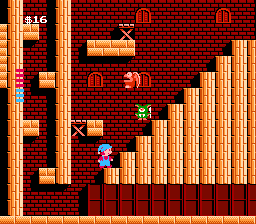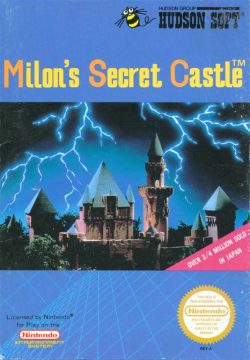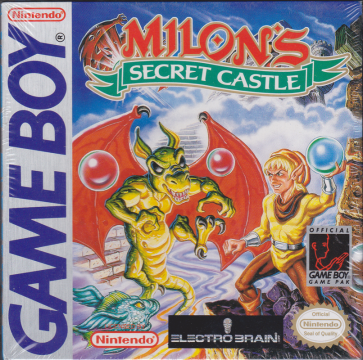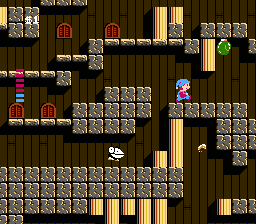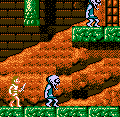Milon’s Secret Castle is an early attempt to blend arcade-like platforming with adventure and puzzle solving, sort of like Super Mario Bros. meets The Tower of Druaga. The hero is tasked with exploring Garland Castle, with the goal being to rescue the kidnapped Queen Eliza being held near the top. The castle area acts as a level select, allowing you to enter any of the doors on a given floor. You’re free to enter any of the doors that you can access, though typically you need to beat a boss or perform some other task before you’re allowed to move upward to the next floor.
Most of the doors contained action levels, where you need to run, jump, and explore in order to find both the key and the exit door. These stages scroll in all directions, making them more complex than many other NES platformers of the time, giving it the sort of complexity typically found in computer games. Milon attacks with a bubble, which is aimed at an upward trajectory, but can be angled downwards by holding down on the d-pad. Once you enter a level, you can’t leave it until you find the exit, but areas can also be revisited even once they’ve been completed.
Some of the doors also contain shops. Here, you can use accumulated cash to purchase items and health replenishments, as well as obtain some vague hints on how to proceed. Most of these items are necessary to proceed through the adventure, like shoes that let you bounce on certain platforms and a lamp to light up dark rooms. Other power-ups are hidden throughout, like honeycombs that permanently extend your life meter. The Hudson bee mascot can also be found, granting him a shield. Beating bosses and taking their crystal also strengthens your main attack.
However, the “secret” part of the game’s title is meant to be taken literally, because almost everything in Milon’s Secret Castle is hidden. The stages consist of blocks, some of which can be destroyed, but it’s never made clear which contain hidden items and which are indestructible blocks. The only way to test is to shoot your bubbles everywhere and at everything, as you uncover money, items, and of course, the aforementioned keys and doors.
Even from the outset, this game revels on its obtusity. Right at the beginning, you’ll find one of the rooms to be empty. The goal is to get the boss monster to spawn, so you can proceed to the next floor. To do this, you need to find the spring shoes, which are found in a shop hidden in one of the stages. The only way to find this shop is by destroying a particular set of blocks, then finding the correct one to push, revealing the secret door needed to find the essential item.
Compounding matters is the fact that navigating the castle is pretty difficult. Milon sort of controls like Mario, in that he moves and jumps with a bit of momentum. But since the game doesn’t have a run button, instead you’ll need to walk for a short moment before he picks up speed, thereby allowing you to jump higher. Your bubble weapon has a short range, and since it can only be aimed upwards or downwards, many of your attacks will fly over the enemies’ head. These foes are also ruthless, attacking from all angles, firing projectiles through walls, and respawn even after being killed. Milon has a short life meter, but without any invincibility period after taking a hit, he can also die pretty quickly from a single enemy encounter.
You only have a single life, and perishing sends you right back to the title screen. If you’ve beaten the first boss, you can continue by holding Left and hitting the Start button. But that’s presuming you’ve even gotten that far, because even taking down this fire-breathing dragon proves to be a tremendous challenge, particularly for an early game foe. It spews out bouncing flame balls at random trajectories, making them hard to predict, and especially hard to dodge given the short range of your bubbles, and you can only take about four hits even with full life. In some ways, this is a litmus test for the game itself, because it just becomes more difficult and more obtuse as it goes on. If you can’t manage the first few levels of the game, you definitely won’t be able to see it through to the end. Even after continuing, you’re not granted full health, so you need to first regain your strength before continuing your journey. Granted, once you know what you’re doing, you can beat the game in about an hour or so, but that of course expects that you’ve learned its secrets inside and out.
This high level of challenge, both with its action gameplay and adventure progression, was expected and even welcome at the time of its release in 1986, particularly in Japan, which was already gaining a subculture around completing these intentionally confusing games. However, it didn’t hit the United States until two years later, by which point it was outclassed by more complex, less frustrating games. Even infamously baffling titles of the era like Castlevania II, Metroid, and Legacy of the Wizard give you large worlds to explore, so even if you didn’t know what you were doing, you could at least get some enjoyment by wandering around and killing things. But Milon’s Secret Castle is much more limited, giving you only comparatively smaller stages to tediously work your way through, presuming the enemies don’t murder you first.
That frustration ends up overwhelming the many little touches that gives Milon’s Secret Castle its charm. Time flows during the game too, as night eventually falls. This doesn’t affect the main stages, but it will cause the castle area to turn dark and cause storm clouds to gather, requiring that you dodge lightning bolts until sunrise. One of the main subquests involves finding music boxes, which will trigger a bonus stage. Here, an orchestra plays while music notes pop up from below, with sharp giving extra points and flats depleting your score. When you first reach this area, the music only has a single instrument, but as you find more and more of them, the instruments begin playing, with the full tune played as you’ve found the final rounds. The Japanese subtitle, Meikyuu Kumikyoku, translates to “Labyrinth Suite”, a musical reference that isn’t quite carried over in the English title, showing how important music is to the theme of the game. The Japanese version of the game also has a timer that challenges you to hit the buttons as many times as possible, a reference to Hudson’s Master Takahashi’s ability to mash buttons, something that would’ve been lost on American gamers.
For as many problems as this game has, its issues feel deliberate rather than sloppy, marking it more of a product of its era than a legitimately poor game. Still, those issues prevent the game from being truly enjoyable, despite its ambitions, and really could’ve used another level of polish. Thankfully, Milon’s Secret Castle got that opportunity with a Game Boy version, released a whole seven years later in 1993. The basic gameplay still hasn’t really changed a whole lot, as even most of the levels are the same, changed only slightly to accommodate the smaller screen. But it is more generous, letting you continue from the beginning without a cheat code, and even includes a password system. In the original version, money didn’t respawn, so you needed to be careful about how you spent your cash. This version replenishes the money when you use a password, so you won’t get caught in poverty due to overspending. Other adjustments have been made to make the game easier, including making the bosses a little less fierce. There’s even a pause menu that shows what items you have, something which isn’t necessarily essential but strangely missing in the NES version. Several music themes have been added too. The original ending was pretty minimal, with only a small congratulations message from the Queen (which changed slightly on subsequent loops), while this version includes a few full screen illustrations of the couple, where Milon suspiciously looks like Link.
Still, it’s not all improvements. Despite being downgraded to monochrome, neither the sprites nor the tiles were made smaller for the tiny screen. This does make it easier to see, but the cramped view makes navigating these multi-directional screens difficult. It’s also filled with substantial amounts of slowdown. Regardless, with all of the improvements elsewhere, this is probably the best way to play the game.
The Famicom version of Milon’s Secret Castle was included on Hudson Best Collection Vol. 3 Action Collection for the Game Boy Advance along with Challenger, though like all of these other similar ports, it’s squished vertically to fit in the system’s resolution. It also saw a sequel on the Super Famicom, called DoReMi Fantasy, which again stars Milon, but removes many of the puzzle solving elements for a more straightforward platforming adventure.
Comparison Screenshots
Links:
Strategy Wiki – Indispensable.
Video Game Museum – Game Boy ending

